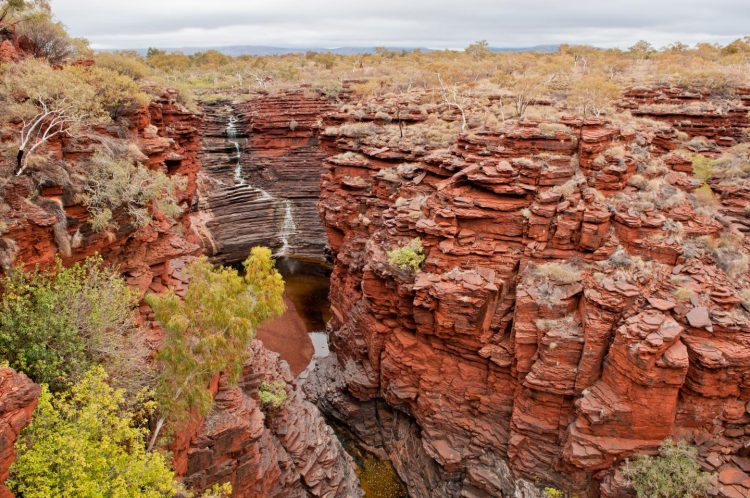Iron: A biological element?

By studying iron extracted from cores drilled in rocks similar to these in Karijini National Park, Western Australia, UW-Madison researchers determined that half of the iron atoms had originated in shallow oceans after being processed by microbes 2.5 billion years ago. Courtesy of Clark Johnson
That's the upshot of a study published this week in the Proceedings of the National Academy of Sciences (PNAS). The findings have meaning for fields as diverse as mining and the search for life in space.
Clark Johnson, a professor of geoscience at the University of Wisconsin-Madison, and former postdoctoral researcher Weiqiang Li examined samples from the banded iron formation in Western Australia. Banded iron is the iron-rich rock found in ore deposits worldwide, from the proposed iron mine in Northern Wisconsin to the enormous mines of Western Australia.
These ancient deposits, up to 150 meters deep, were begging for explanation, says Johnson.
Scientists thought the iron had entered the ocean from hot, mineral-rich water released at mid-ocean vents that then precipitated to the ocean floor. Now Johnson and Li, who is currently at Nanjing University in China, show that half of the iron in banded iron was metabolized by ancient bacteria living along the continental shelves.
The banding was thought to represent some sort of seasonal changes. The UW-Madison researchers found long-term swings in the composition, but not variations on shorter periods like decades or centuries.
The study began with precise measurements of isotopes of iron and neodymium using one of the world's fastest lasers, housed in the UW-Madison geoscience department. (Isotopes, forms of an atom that differ only by weight, are often used to “fingerprint” the source of various samples.)
Bursts of light less than one-trillionth of a second long vaporized thin sections of the sample without heating the sample itself. “It's like taking an ice cream scoop and quickly pulling out material before it gets heated,” Johnson explains.
“Heating with traditional lasers gave spurious results.”
It took three years to perfect the working of the laser and associated mass spectrometry instruments, Li says.
Previous probes of the source of banded iron had focused on iron isotopes. “There has been debate about what the iron isotopes were telling us about the source,” Li says. “Adding neodymium changed that picture and gave us an independent measure of the amount coming from shallow continental waters that carried an isotopic signature of life.”
The idea that an organism could metabolize iron may seem strange today, but Earth was very different 2.5 billion years ago. With little oxygen in the atmosphere, many organisms derived energy by metabolizing iron instead of oxygen.
Biologists say this process “is really deep in the tree of life, but we've had little evidence from the rock record until now,” Johnson says. “These ancient microbes were respiring iron just like we respire oxygen. It's a hard thing to wrap your head around, I admit.”
The current study is important in several ways, Johnson says. “If you are an exploration geologist, you want to know the source of the minerals so you know where to explore.”
The research also clarifies the evolution of our planet — and of life itself — during the “iron-rich” era 2.5 billion years ago. “What vestiges of the iron-rich world remain in our metabolism?” Johnson asks. “It's no accident that iron is an important part of life, that early biological molecules may have been iron-based.”
NASA has made the search for life in space a major focus and sponsors the UW-Madison Astrobiology Institute, which Johnson directs. Recognizing unfamiliar forms of life is a priority for the space agency.
The study reinforces the importance of microbes in geology. “This represents a huge change,” Johnson says. “In my introductory geochemistry textbook from 1980, there is no mention of biology, and so every diagram showing what minerals are stable at what conditions on the surface of the Earth is absolutely wrong.”
Research results like these affect how classes are taught, Johnson says. “If I only taught the same thing, I would be teaching things that are absolutely wrong. If you ever wonder why we combine teaching and research at this university, geomicrobiology gives you the answer. It has completely turned geoscience on its ear.”
Contact:
David Tenenbaum
djtenenb@wisc.edu
608-265-8549
Clark Johnson
clarkj@geology.wisc.edu (preference)
608-262-1710
Media Contact
All latest news from the category: Life Sciences and Chemistry
Articles and reports from the Life Sciences and chemistry area deal with applied and basic research into modern biology, chemistry and human medicine.
Valuable information can be found on a range of life sciences fields including bacteriology, biochemistry, bionics, bioinformatics, biophysics, biotechnology, genetics, geobotany, human biology, marine biology, microbiology, molecular biology, cellular biology, zoology, bioinorganic chemistry, microchemistry and environmental chemistry.
Newest articles

First-of-its-kind study uses remote sensing to monitor plastic debris in rivers and lakes
Remote sensing creates a cost-effective solution to monitoring plastic pollution. A first-of-its-kind study from researchers at the University of Minnesota Twin Cities shows how remote sensing can help monitor and…

Laser-based artificial neuron mimics nerve cell functions at lightning speed
With a processing speed a billion times faster than nature, chip-based laser neuron could help advance AI tasks such as pattern recognition and sequence prediction. Researchers have developed a laser-based…

Optimising the processing of plastic waste
Just one look in the yellow bin reveals a colourful jumble of different types of plastic. However, the purer and more uniform plastic waste is, the easier it is to…



